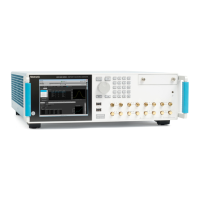Specifications
Table 22: Ref In
(reference input)
Characteristics Description
Connector type SMA on rear panel.
Input impeda
nce
50 Ω (AC coupled).
Input ampli
tude
–5 dBm to +5 d
Bm.
Fixed frequ
ency range
10 MHz, ±40 Hz.
Variable f
requency range
35 MHz to 240 MHz.
Acceptabl
e frequency drift while the instrument is operating is ± 0.1%.
Table 23: Clock Out
Characteristics Description
The external clock output is a copy of an internal clock generator that is used to create the
DAC sample clock. This clock always operates in the octave range specified below. It is
multiplied and divided to create the effective DAC sampling rate.
Connector type SMA on rear panel.
Output impedance 50 Ω AC coupled.
Output amplitude
+3 dBm to +10 dBm.
Frequency range
2.5GHzto5GHz.
For sample rates lower than 2.5 GS/s the output frequency is: Fout = SR * 2n ; where n is an
integer that gives Fout between 2.5 GHz and 5 GHz.
Frequency resolution
Internal and fixed reference
clock operation
With jitter reduction: 50 MHz.
Without jitter reduction: 100 MHz ÷ 2
20
.
With jitter reduction: Fref ÷ R.
Without jitter reduction: Fref ÷ R ÷ 2
20
External variable reference
clock operation
Fref = reference clock frequency
R = 4 when 140 MHz < Fref ≤ 240 MHz
R = 2 when 70 MHz < Fref ≤ 140 MHz
R = 1 when 35 MHz ≤ Fref ≤ 70 MHz
Table 24: Clock In
Characteristics Description
The external clock input can be used to create the DAC s ample clock. This clock must always
operate in the octave range specified below. It is multiplied and divided to create the actual
DAC sample clock.
Connector type SMA on rear panel.
Input impedance
50 Ω (AC coupled).
Input amplitude 0 dBm to +10 dBm.
Frequency range
2.5GHzto5GHz.
Acceptable frequency drift while the instrument is operating is ±0.1% .
AWG5200 Series Technical Reference 17

